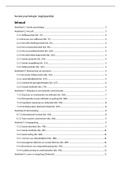Resume
Samenvatting Sociale psychologie, begrippenlijst
D.m.v. deze begrippenlijst een 8,2 gehaald! Bevat begrippen met betekenis uit de hoofdstukken 1,2,3,7,8,9 uit het boek Sociale psychologie - Roos Vonk. De begrippenlijst is geschreven voor het vak Sociale psychologie - Toegepaste psychologie op Fontys hogescholen Eindhoven.
[Montrer plus]
Livre entier ?
Non
Quels chapitres sont résumés ?
Hoofdstuk 1,2,3,7,8,9
Publié le
16 août 2021
Nombre de pages
13
Écrit en
2020/2021
Type
Resume
Titre de l’ouvrage: Sociale Psychologie
Auteur(s): R. Vonk
Édition: juli 2017 ISBN: 9789089537850 Édition: 4
Resume
Sociale psychologie samenvatting van het boek, 8 gehaald
Resume
Samenvatting Sociale Psychologie (boek en colleges)
Resume
Samenvatting Sociale psychologie, tentamen Fontys - Behaald: 8,8!
Tout pour ce livre (39)
Établissement
Fontys Hogeschool (Fontys)
Cours
Toegepaste Psychologie
Cours
Sociale Psychologie (TP1CSOPSY)
Tous les documents sur ce sujet (34)
Par: lindseyjoosen • 2 année de cela
S'abonner
€5,86
Egalement disponible en groupe à partir de €23,49
Garantie de satisfaction à 100%
Disponible immédiatement après paiement
En ligne et en PDF
Tu n'es attaché à rien
Document également disponible en groupe (1)
Theorievakken (5x) Toegepaste Psychologie - Fontys jaar 1, samenvattingen & begrippenlijsten
€ 29,30
€ 23,49
5 éléments
1. Resume - Inleiding in de psychologie, samenvatting & begrippenlijst
2. Resume - Persoonlijkheidsleer, samenvatting & begrippenlijst
3. Resume - Ontwikkelingspsychologie, samenvatting
4. Resume - Sociale psychologie, begrippenlijst
5. Resume - Spss, samenvatting
Montrer plus
Sociale psychologie; begrippenlijst





